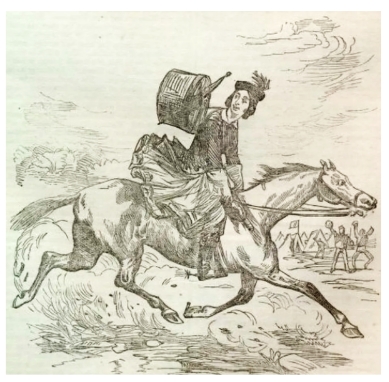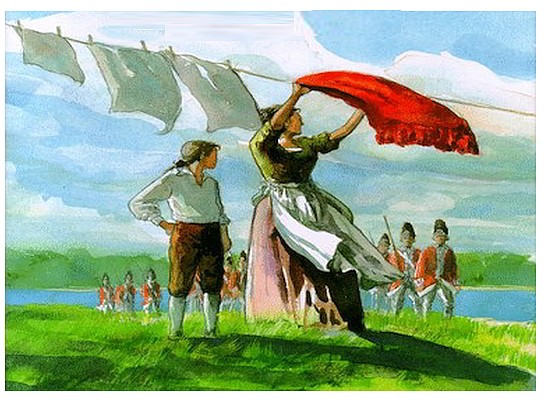March 29, 2024 at 8:39 a.m.
The Culper Ring and Agent 355
Compiled by Jennifer Baker, DAR Vesuvius Furnace Chapter
Yes, spies and espionage were a thing during the Revolution. A large number of them were women and they employed techniques that were well ahead of their time. Spies were critical, with some early colonial victories being a direct result of espionage. Things such as code names, ciphers, and even invisible ink were used.
Early in 1777, American Colonel Elias Dayton set up a spy network on Staten Island, which worked with an established network known as the Mersereau Ring.
The Culper Ring was the most infamous and important. It took around 150 years for this secret network to be made known to the public.
The Culper Ring was a network of spies active during the American Revolutionary War, organized by Major Benjamin Tallmadge and General George Washington in 1778 during the British occupation of New York City. The name "Culper" was suggested by George Washington and taken from Culpeper County, Virginia. The leaders of the spy ring were Abraham Woodhull and Robert Townsend, using the aliases of "Samuel Culper Sr." and "Samuel Culper Jr." respectively; Tallmadge was referred to as "John Bolton."
While Tallmadge was the spies' direct contact, Washington often directed their operations. The ring was tasked to provide Washington information on British Army operations in New York City, the British headquarters. Its members operated mostly in New York City, Long Island, and Connecticut between late October 1778 and the British evacuation of New York in 1783.
The information supplied by the spy ring included details of a surprise attack on the newly arrived French forces under Lieutenant General Rochambeau at Newport, Rhode Island, before they had recovered from their arduous sea voyage, as well as a British plan to counterfeit American currency on the actual paper used for Continental dollars, which prompted the Continental Congress to retire the bills.
The ring also informed Washington that Tryon's raid of July 1779 was intended to divide his forces and allow Lieutenant General Sir Henry Clinton to attack them piecemeal. In 1780, the Culper Ring discovered a high-ranking American officer, subsequently identified as Benedict Arnold, was plotting with British Major John André to turn over the vitally important American fort at West Point, New York on the Hudson River and surrender its garrison to the British forces.
Woodhull traveled to New York City every few weeks to gather intelligence. His married sister, Mary Underhill, lived there and gave him a valid reason to visit. He was questioned at a British checkpoint on October 31, 1778, which increased his anxiety about the dangerous mission, but he returned to Setauket with valuable information about the British supply fleet. He provided a precise report on November 23 with the identity of British units and the numbers of troops and dispositions in New York City, which proved his worth as a spy. Woodhull soon recruited his brother-in-law, Amos Underhill, to gather intelligence; the latter ran a boarding house in the city near East Setauket with his wife, Mary, but Underhill's reports were often too vague to be of much value.
Local tradition claims that Anna Strong, a resident of Setauket and a friend and neighbor of Abraham Woodhull, helped pass along messages from the spy ring by posting prearranged signals to indicate when one of the spies was ready to submit intelligence. If she hung a black petticoat on her clothesline, it meant that Brewster had arrived in town in his whaleboat. Also, she would hang a quantity of white handkerchiefs to indicate which of the six hiding places he was in. Woodhull used her signals to meet Brewster or to drop messages at one of the meeting places. The historian Richard Welch writes that the tradition of the clothesline signal is unverifiable, but it is known that the British suspected a Setauket woman who fit Anna's profile of Patriot activities.
Brewster occasionally would add his own report to the Culper messages. In a January 1779 report received by Washington in early February, Brewster sent some information about naval matters and boat building at New York City and warned that Loyalists were outfitting privateers for operations on Long Island Sound. That was delivered with a message from Woodhull that precisely described the British regiments and commanders at the northern tip of Manhattan, totaling about 8,500 men. Woodhull also reported on British boatbuilding, confirming Brewster's report. Tallmadge and Washington thought that the boats might be planned for transport for an attack against Connecticut from Major General William Tryon, who had conducted a raid during the winter.
Secrecy was so strict that Washington did not know the identity of all of the operatives. Townsend was recruited by Woodhull, who was especially insistent that his identity is not revealed, although Austin Roe and Jonas Hawkins needed to know him.
Among the techniques that the Culper Ring used to relay information were coded messages published in newspapers and invisible ink, called a sympathetic stain, to write between the lines of what appeared to be typical letters. In the first months of the ring's operations, they were forced to rely on crude tactics to conceal their information before a complex web of codes and invisible ink were accessible, and so they relied on a small number of codes for memory. Woodhull used the codes 10 (New York), 30 and 40 (Post Riders), and 20 (Setauket) in his first letter of correspondence.
 Most of the agent’s identities have been discovered, Washington's code number was 711. However, the identity of a female, agent 355, is still a complete mystery to this day. Women were not considered threats to military commanders, allowing them to spy uninterrupted. Women who were cooks and maids were recruited to spy on soldiers. A prominent woman who played a major role in the Culper Spy ring was Agent 355. Agent 355 was best known for providing the intelligence that led to the capture of the treasonous Benedict Arnold. While some sources make note of Agent 355 as an intelligence gatherer, others believe the code number simply referred to Anna Strong or was a misunderstanding of a cryptic reference in one of Abraham Woodhull's letters. Other women were informants for the Culper Ring, such as Robert Townsend's sister Sarah (Sally) Townsend and Abraham Woodhull's sister Mary Underhill, who provided important information about Major John Andre and his alias of John Anderson, according to some sources.
Most of the agent’s identities have been discovered, Washington's code number was 711. However, the identity of a female, agent 355, is still a complete mystery to this day. Women were not considered threats to military commanders, allowing them to spy uninterrupted. Women who were cooks and maids were recruited to spy on soldiers. A prominent woman who played a major role in the Culper Spy ring was Agent 355. Agent 355 was best known for providing the intelligence that led to the capture of the treasonous Benedict Arnold. While some sources make note of Agent 355 as an intelligence gatherer, others believe the code number simply referred to Anna Strong or was a misunderstanding of a cryptic reference in one of Abraham Woodhull's letters. Other women were informants for the Culper Ring, such as Robert Townsend's sister Sarah (Sally) Townsend and Abraham Woodhull's sister Mary Underhill, who provided important information about Major John Andre and his alias of John Anderson, according to some sources.
While the true identity of 355 remains unknown, some facts about her seem clear. She worked with the American Patriots during the Revolutionary War as a spy and was likely recruited by Woodhull into the spy ring. The way the code is constructed indicates that she may have had "some degree of social prominence." She was likely living in New York City at the time, and at some point had contact with Major John André and Benedict Arnold. 355 is thought to have played a major role in exposing Arnold as a defector and in the arrest of André, who was hanged in Tappan, New York. She may have been a member of a prominent Loyalist family, which would have put her within easy reach of British commanders.
Agent 355 has become a part of popular fiction showing up in comic books, television shows, novels, and motion pictures.





Comments:
You must login to comment.